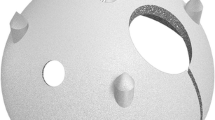Summary
Comparable patient populations with 160 uncoated RM acetabular cups and 263 cemented Müller standard acetabular cups were submitted to survivaltime analysis in a retrospective study with a mean followup of 5.3 years for the RM cup and 6.1 years for the Müller cup. After 7–8 years 12% of the RM cups and 4% of the Müller cups had been exchanged, 40% and 15% respectively were loose. The poor performance of the RM cups is ascribed to additional external polyethylene wear, which leads to the formation of granulomas and destroys the weight-bearing osseous structures. Similar granulomas also develop on the proximal stem and thus endanger the same.
Similar content being viewed by others
References
Aldinger G, Gekeler J (1982) Aseptic loosening of cement-anchored total hip replacement. Arch Orthop Trauma Surg 100:19–25
Bertin KC, Freeman MAR, Morscher E, Oeri A, Ring PA (1985) Cementless acetabular replacement using a pegged polyethylene prosthesis. Arch Orthop Trauma Surg 104:251–261
Buchhorn U, Willert HG, Semlitsch M, Weber H (1984) Dimensionsänderungen der Polyäthylen-Hüftpfannen bei Müller-Hüftendoprothesen. Z Orthop 122:127–135
Dobbs SH (1980) Survivorship of total hip replacements. J Bone Joint Surg [Br] 62:168–176
Dorey F, Armstutz HC (1989) The validity of survivorship analysis in total joint arthroplasty. J Bone Joint Surg [Am] 71:544–548
Eyerer R (1985) Reader's letter on: W. Remagen and E. Morscher: Histological results with cement-free implanted hip joint sockets of polyethylene. Arch Orthop Trauma Surg 104:265
Goldring SR, Shiller AL, Roelke M, Rourke CM, O'Neill DA, Harris WH (1983) The synovial-like membrane at the bone-cement interface in loose total hip replacements and its proposed role in bone lysis. J Bone Joint Surg [Am] 65:575–585
Griffith MJ, Seidenstein MK, Williams D, Charnley J (1978) Eight year results of Charnley arthroplasties of the hip with special reference to the behavior of cement. Clin Orthop 137:24–36
Mathys R (1983) Möglichkeiten des künstlichen Knochen- und Gelenkersatzes mit isoelastischen RM-Prothesen. Z Orthop 121:441
Morscher E, Dick W (1983) Zementlose Verankerung einer Häftgelenkspfanne aus Polyäthylen. In: Morscher E (ed) Die zementlose Fixation von Hüftendoprothesen. Springer, Berlin Heidelberg NewYork, pp 205–209
Morscher E, Dick W (1983) Cementless fixation of “isoelastic” hip endoprosthesis manufactured from plastic materials. Clin Orthop 176:77–87
Morscher E, Dick W, Kernen V (1982) Cementless fixation of polyethylene acetabular component in total hip arthroplasty. Arch Orthop Trauma Surg 99:223–230
Muhr G, Stockhusen H, Müller O (1976) Die Hüftarthroplastik mit isoelastischen Totalprothesen im Tierexperiment. Arch Orthop Unfall-Chir 86:115–128
Olsson SS, Jernberger A, Tryggö D (1981) Clinical and radiological long-term results after Charnley-Müller total hip replacement. A 5- to 10-year follow-up study with special reference to aseptic loosening. Acta Orthop Scand 52:531–542
Poigenfürst J, Scharf W, Mahringer C, Pankarter F (1984) Vorläufige Ergebnisse nach Implantaten isoelastischer zementfreier Hüftpfannen. Aktuel Traumatol 14:271–274
Remagen W, Morscher E (1984) Histological results with cement-free implanted hip joint sockets of polyethylene. Arch Orthop Trauma Surg 103:145–151
Russe W (1988) Röntgenphotogrammetrie der künstlichen Hüftgelenkspfanne. Huber, Bern
Schumacher M (1989) Probleme der statistischen Auswertung von Überlebensstudien. Z Orthop 127:428–432
Sutherland CJ, Wilde AH, Borden LS, Marks KE (1982) A ten-year follow-up of one hundred consecutive Müller curvedstem total hip-replacement arthroplasties. J Bone Joint Surg [Am] 64:970–982
Träger D, Rode P, Krause W (1985) Erfahrungen mit der RMisoelastischen Hüft-Endoprothese. Chirurg 56:718–722
Ungethtim M, Winkler-Gniewek W (1983) Untersuchung des Verschleisses an Polyäthylenkomponenten von Endoprothesen nach klinischem Einsatz. Z Orthop 121:638–691
Willert HG, Buchhorn U, Hess T (1989) Die Bedeutung von Abrieb und Materialermüdung bei der Prothesenlockerung an der Hüfte. Orthopäde 18:350–369
Wilson-McDonald J, Morscher E, Masar Z (1990) Cementless uncoated polyethylene acetabular components in total hip replacement. Review of 5- to 10-year results. J Bone Joint Surg [Br] 72:423–430
Author information
Authors and Affiliations
Rights and permissions
About this article
Cite this article
Krismer, M., Fischer, M., Klestil, T. et al. Uncoated polyethylene RM acetabular component versus Müller cemented acetabular component A 4- to 8-year follow-up study. Arch Orthop Trauma Surg 110, 195–199 (1991). https://doi.org/10.1007/BF00571058
Issue Date:
DOI: https://doi.org/10.1007/BF00571058




